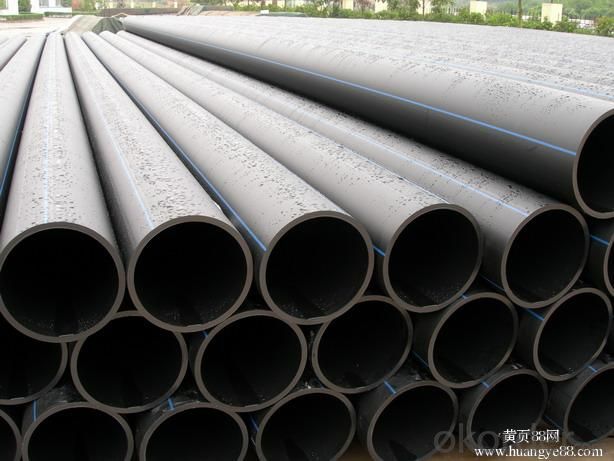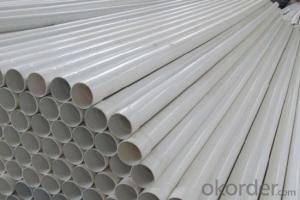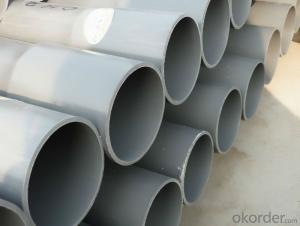HDPE Pipe ISO4427-2000 DN110 Plastic Tubes
- Loading Port:
- China Main Port
- Payment Terms:
- TT OR LC
- Min Order Qty:
- -
- Supply Capability:
- -
OKorder Service Pledge
OKorder Financial Service
You Might Also Like
Physical properties[edit]
Polyethylene is a thermoplasticpolymer consisting of long hydrocarbon chains. Depending on the crystallinity and molecular weight, a melting point and glass transition may or may not be observable. The temperature at which these occur varies strongly with the type of polyethylene. For common commercial grades of medium- and high-density polyethylene the melting point is typically in the range 120 to 180 °C (248 to 356 °F). The melting point for average, commercial, low-density polyethylene is typically 105 to 115 °C (221 to 239 °F).it is transprant.
Chemical properties[edit]
Most LDPE, MDPE and HDPE grades have excellent chemical resistance, meaning that it is not attacked by strong acids or strong bases. It is also resistant to gentle oxidants and reducing agents. Polyethylene burns slowly with a blue flame having a yellow tip and gives off an odour of paraffin. The material continues burning on removal of the flame source and produces a drip.[3] Crystalline samples do not dissolve at room temperature. Polyethylene (other than cross-linked polyethylene) usually can be dissolved at elevated temperatures in aromatic hydrocarbons such as toluene or xylene, or in chlorinated solvents such as trichloroethane or trichlorobenzene.[4]
GB/T13663-2000:
| PE63管材规格 | |||||
| 公称 外径dn,mm | SDR33 | SDR26 | SDR17.6 | SDR13.6 | SDR11 |
| 公称压力 PN,Mpa | |||||
| 0.32 | 0.4 | 0.6 | 0.8 | 1.0 | |
| 公称 壁厚 | 公称 壁厚 | 公称 壁厚 | 公称 壁厚 | 公称 壁厚 | |
| 16 | 2.3 | ||||
| 20 | 2.3 | 2.3 | |||
| 25 | 2.3 | 2.3 | 2.3 | ||
| 32 | 2.3 | 2.4 | 2.9 | ||
| 40 | 2.3 | 2.3 | 3.0 | 3.7 | |
| 50 | 2.3 | 2.9 | 3.7 | 4.6 | |
| 63 | 2.3 | 2.5 | 3.6 | 4.7 | 5.8 |
| 75 | 2.3 | 2.9 | 4.3 | 5.6 | 6.8 |
| 90 | 2.8 | 3.5 | 5.1 | 6.7 | 8.2 |
| 110 | 3.4 | 4.2 | 6.3 | 8.1 | 10.0 |
| 125 | 3.9 | 4.8 | 7.1 | 9.2 | 11.4 |
| 140 | 4.3 | 5.4 | 8.0 | 10.3 | 12.7 |
| 160 | 4.9 | 6.2 | 9.1 | 11.8 | 14.6 |
| 180 | 5.5 | 6.9 | 10.2 | 13.3 | 16.4 |
| 200 | 6.2 | 7.7 | 11.4 | 14.7 | 18.2 |
| 225 | 6.9 | 8.6 | 12.8 | 16.6 | 20.5 |
| 250 | 7.7 | 9.6 | 14.2 | 18.4 | 22.7 |
| 280 | 8.6 | 10.7 | 15.9 | 20.6 | 25.4 |
| 315 | 9.7 | 12.1 | 17.9 | 23.2 | 28.6 |
| 355 | 10.9 | 13.6 | 20.1 | 26.1 | 32.2 |
| 400 | 12.3 | 15.3 | 22.7 | 29.4 | 36.3 |
| 450 | 13.8 | 17.2 | 25.5 | 33.1 | 40.9 |
| 500 | 15.3 | 19.1 | 28.3 | 36.8 | 45.4 |
| 560 | 17.2 | 21.4 | 31.7 | 41.2 | 50.8 |
| 630 | 19.3 | 24.1 | 35.7 | 46.3 | 57.2 |
- Q: What is the transition metal pipe between the plastic water supply pipe and the water heater?
- In the PP-R piping system, the transition between the metal pipe and the plastic pipe needs a transition piece, the transition piece and the PP-R pipe are connected by hot melt, and the transition part is connected with the metal pipe through a screw thread.
- Q: What exactly is tubes in ears?
- earlier tubes, the accepted practitioner ought to locate out why the an infection. She could have hypersensitive reactions that require drugs to maintain her passages sparkling. My 7 year previous is on her 2d set of tubes. She had them put in via fact she have been given a great form of infections and while she did no longer have an infection, she had plenty thick fluid in her ears that she had a listening to loss. the 1st set stayed in her ears for a million year and then fell out. The fluid got here decrease back and he or she had to have the 2d set put in. Ear tubes are little disc-looking issues that save the ear canal sparkling of fluid. they're put in at a wellbeing middle below accepted anesthesia. I quite have never heard of long term problems with tubes, yet there is not any assure that they are going to stay in for an prolonged time and next surgical procedures are very achievable. talk over with the expert and notice if he recommends hypersensitive reaction attempting out first. i could in basic terms have the surgical treatment as a final motel.
- Q: Are plastic tubes resistant to static electricity?
- Plastic tubes are generally not resistant to static electricity, as they are insulators that do not conduct electricity.
- Q: Are plastic tubes transparent or opaque?
- Plastic tubes can be transparent or opaque, depending on the type of plastic used and its color.
- Q: I make models and the plastic that winds up in the trash could be reused if only I knew how to glue it. I have tried all of mine (401, epoxy, Loctite, Gorilla Glue, etc) to no avail.
- I use E-6000 clear glue for almost everything. I am a sewer and needed some weights so I used this glue on huge metal washers putting two of them together for more weight. I have had these weights for quite a few years. The trick to this glue is to let is set. According to the label is it flexible, paintable, non-flammable, waterproof, safe for photographs, etc. I would suggest not using this in an enclosed area for any length of time. Good luck - Hope that helps.
- Q: How are plastic tubes stored to maintain their shape?
- Plastic tubes are typically stored in a straight and vertical position to maintain their shape. They can be placed in specially designed racks or holders, ensuring that they are not bent or twisted. This storage method prevents any deformation or warping of the tubes, allowing them to retain their intended shape.
- Q: How do I heat the thin plastic tube?
- Generally do not use thin plastic tube heating, if it must be heated, it must be heated water bath, to prevent the temperature is too high and burned containers.
- Q: When a mechanic wants to empty a gasoline tank of a car,he fills a plastic tube with gasoline,dips one end of the tube into the gasoline in the tank,and puts the one end at a empty drum lower than the gasoline tank of the car.Why does this technique work?
- its actually a working model of a syphen pump actually the receiving end is at a lesser height so due to the pull of the mouth the fluid rises and due to less altitude flows down creating vacuum which the remaining liquid seeks to fill thus acting like a pump
- Q: How do you get a plastic tube on your shoelace? What's the name of the machine? Thank you
- Shoelace heading machine, according to the operation mode is divided into semi-automatic shoelace heading machine and automatic shoelace leading machine two kinds. The semi-automatic shoelace heading machine uses the artificial feeding, manual control of length and manual control of the machine in Baotou. The utility model has the advantages of flexibility and convenient length adjustment, and is suitable for small batch production or proofing use. The output and quality are directly related to the operator. Automatic shoelace tipping machine, the difference between semi-automatic place lies in his high degree of automation, feeding, length control, quantity statistics and machine Baotou action are carried out automatically, workers only need to take out the finished packaging can be. Important for mass production.
- Q: Are plastic tubes durable?
- Yes, plastic tubes are generally durable. They are designed to withstand various environmental conditions and can resist impact, corrosion, and other forms of damage. However, the durability of plastic tubes may vary depending on their thickness, quality, and the specific application they are used for.
Send your message to us
HDPE Pipe ISO4427-2000 DN110 Plastic Tubes
- Loading Port:
- China Main Port
- Payment Terms:
- TT OR LC
- Min Order Qty:
- -
- Supply Capability:
- -
OKorder Service Pledge
OKorder Financial Service
Similar products
Hot products
Hot Searches
Related keywords






















